Menus
- A tasty mix of genres
- Introduction
- Presentation
- In the saddle
- In the city
- Motorway and expressways
- Departmental
- Braking
- Comfort and duo
- Driving aids
- Practical aspects and accessories
- Consumption
- Conclusion
- Skills
A tasty mix of genres
Ducati has barely unveiled its all-new Hypermotard that the Hyperstrada, a more versatile GTized version with a windshield, side cases and a center stand, is immediately released.. The marriage of diametrically opposed genders could have heralded a catastrophe, fortunately it is not even if the formula will need to be fine-tuned to be completely homogeneous.
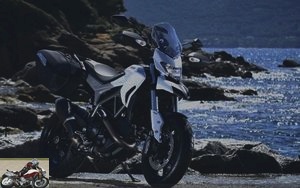
Introduction
The thinking heads of Ducati, probably from the marketing department, had the sulphurous idea of creating GT versions of several models in their range, brought together under the name Strada. We therefore find in the 2013 catalog a Multistrada Granturismo, a Diavel Strada, and…. a Hyperstrada! For the first one, perfect! An ultra-accessorized version capable of getting rid of a world tour without cramping or sore buttocks, that’s perfect. For the second, why not. A Power Cruiser capable of eating from the terminal should at least appeal to a not insignificant fringe of the American biker population. On the other hand, one thinks at first glance that you have to seriously abuse illicit substances to have the idea of grafting suitcases and windshields onto a supermotard…. It’s not knowing Ducati well, especially when looking at the list of modifications to the Hyperstrada, both of which are just the tip of the iceberg. !
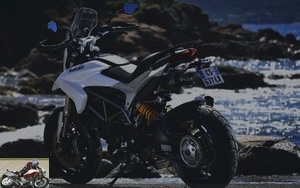
Presentation
Do you know the Hypermotard? Launched in 2007, this attractive plastic twin-cylinder supermotard has seen only confidential distribution despite undeniable qualities: torquey and expressive engine, chassis combining liveliness and precision…. Except that the beautiful inherited in passing all the inherent flaws of the genre, starting with a high-pitched saddle and ridiculous autonomy. The next evolution, dubbed EVO (logic….) Improves performance and consistency without erasing its initial flaws. Worse, the raised chassis to gain more angle on the SP version (875 mm) made the saddle peak at Hymalaïesque heights.
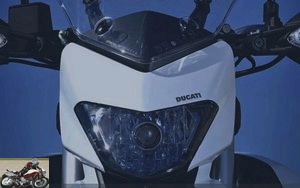
Suddenly, Ducati has almost completely revised its copy this year with a 100% new model. The engine is a liquid-cooled 821 cc 11 ° Testastretta developing 110 hp at 9,250 rpm (106 in our market) for a torque of 89 Nm at 7,750 rpm. This twin-cylinder with 4 valves per cylinder is derived from the 848 block but adopts less super square dimensions in order to promote torque. Its lower performance also allowed the service intervals to be extended to 15,000 km / 12 months and the valve clearance check to 30,000 km. On the chassis side, the mixed frame is also unique, combining a tubular trellis at the front and a removable aluminum and polymer buckle at the rear. Among the other notable changes, it is also necessary to announce the adoption of an inverted fork of 43 mm nonadjustable of origin Kayaba and of a shock absorber Sachs adjustable in preload and in hydraulic and a new tank of 16 liters of capacity against 12 , 5 previously. So much for the standard version.
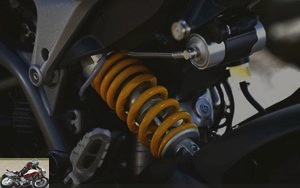
After this long description, I invite you to take an aspirin before attacking the specifics of Hyperstrada…. On this basis, Ducati has added a touring saddle that is both wider and more comfortable for the driver and his passenger. The latter is also entitled to an ergonomically modified grab handle to withstand long journeys. The pilot is not left out with a trigger guard raising the handlebars by 20 mm and a high screen overhanging the dashboard. Vocation GT requires, the Hyperstrada is also entitled to a pair of semi-rigid side cases with a capacity of 25 liters each and a center stand to facilitate maintenance of the chain drive. A shock absorber preload adjustment knob, two 12 V sockets located under the saddle and front and rear wheel lickers are also standard equipment. As for the Pirelli Diablo Rosso II tires, they are replaced here by Scorpion Trail, like the Multistrada 1200. Finally, note that Ducati has thought of small templates with a saddle height lowered from 870 to 850 mm. If that is not enough a low (830 mm) or ultra-low (810 mm) saddle option is also available for the really "little ones".
In the saddle
First satisfaction, settling on a Hypermotard no longer looks like a climbing session. From the height of my meter seventy, all my toes touch the ground. However, you must have flexible adductors when lifting your leg so as not to scratch the side cases. The seat is comfortable and the handlebars fall more naturally to the hands than the Hypermotard, although its very close position may confuse roadster owners for the first few kilometers. The controls are soft but the mirrors deserve to be farther apart to do their job perfectly. The general finish is very good with a special mention for the single-sided arm. The table is ultra complete despite its small size and can display the total mileage, two partials, the time, the engine or ambient temperature, the instantaneous or average consumption, the average speed and even the driving time via the buttons on the left stalk. . It is through the same buttons that you access the different “Riding Modes” which allow you to adjust the level of driving aids (ABS + traction control) and the response of the Ride by Wire accelerator, but we will come back to this later. little further.
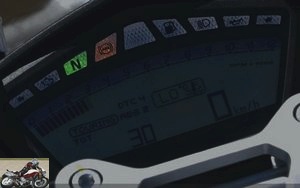
It’s all the more time to get started as our driving program is so tempting: Corsica, sunshine and lots of bends ….
In the city
The Island of Beauty is unlike yours with a bottled metropolis but the rare towns crossed, with the appearance of a snail, highlighted the progressiveness of the Ride by Wire and the surprising flexibility of the Testastretta 11 °, capable of picking up on a trickle of gas from 2000 rpm on the first three reports despite a too long final transmission (a habit at Ducati). The gain is all the more noticeable in the face of a “2 valve” as the much more gradual arrival of torque makes it possible to regulate its pace to the nearest km / h. Very practical, especially when passing in front of an automatic radar…. And the turning radius bodes well for great potential in gymkhana mode between cars. The gearbox is a bit rough, especially when downshifting, but the varying consistency between our low-mileage test machines suggests that it is the running-in that will determine the overall smoothness. Only the braking will require a period of habituation, the fault of a very – too – pronounced bite. With a well-adjusted guard and a little getting used to, we manage to curb the phenomenon but we still bless the presence of ABS by imagining reflex braking on a rainy day. In short, so far, the Hyperstrada has done almost everything.
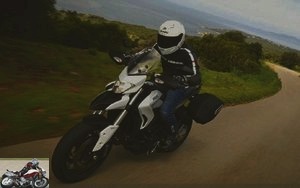
Motorway and expressways
The opportunities to exceed 120 km / h during our journey were rather rare. However, the stability of the Hyperstrada has never been faulted despite a geometry that strongly favors handling. Provided of course not to hang on to the handlebars during the acceleration phases but the hollow saddle which wedges the kidneys, unlike most supermotards in the competition, makes the phenomenon anecdotal.
Luggage storage doesn’t seem to interfere with the aerodynamics either, at least in legal terms. As for the bubble, high and narrow, it relieves the bust and the helmet of a good part of the wind pressure but leaves the arms and shoulders too exposed to really protect in the event of a downpour..
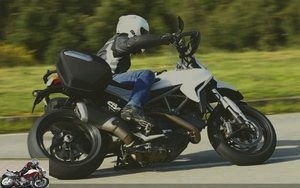
Departmental
Pseudo-GT as it is, the Hyperstrada finds its home ground on the secondary network. The more it turns, the more she likes it. The new twin is admittedly less torquey and temperamental at low revs than the old model, but the advertised 110 horsepower is there and the front end naturally shifts in first gear and even in second with a little help from the clutch..
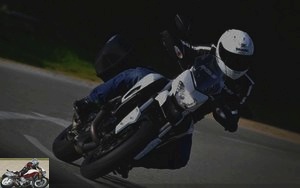
The thrust really starts at 4,000 rpm and climbs steadily up to 8,500 rpm, where the power begins to regulate. For optimum efficiency, it is best to keep the needle above 6,000 turns. The Hyperstrada’s vocalizations are discreet at low revs (for a Ducati) but then we find the metallic tone typical of all Testastretta. Pleasant. The chassis is in tune but requires a different user manual from roadsters. The very light front offers a puzzling liveliness while the rear follows without batting an eyelid. Once you realize that it only takes three grams of pressure on the handlebars to turn, you can ride at breakneck speed with the peace of mind that driver aids provide. ABS and traction control are on the lookout! And the state of the asphalt has little influence on handling, thanks to supple and well-tuned suspensions despite a lack of hydraulic finesse. Unfortunately, there are still a few fuses to bypass. The fork, too flexible at the start of the race (and not adjustable), tends to dive excessively on very heavy braking without affecting the stability. And then there is the ground clearance…. In the countless bends crisscrossing the Corsican hinterland, the center stand then the selector more than once rubbed the asphalt, adopting the driving style typical of supermotards. In tight turns, it is therefore better to fall back on a more academic steering, straight or swaying, to fully exploit the ground clearance. Adding a few more turns on the preload wheel should also allow a few degrees of angle to be gained, but the raised attitude could then make the front end too sharp. There remains the solution of removing the central stand and raising the selector, but if you think you will reach this end, it is better to fall back on the SP model. Driven with beating speed, the Scorpion Trail keep up the pace perfectly and have never shown any inclination to stall.
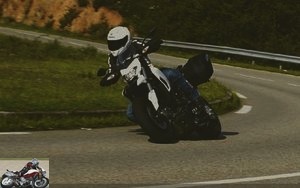
Braking
Braking at Ducati is a bit like at Porsche, their systems are difficult to criticize. The power and feel are impeccable here, and the bit too much bite is only annoying because the fork is a little too soft. The same goes for ABS, transparent in all available modes. In the most permissive setting, it is even possible to lift the rear wheel ….
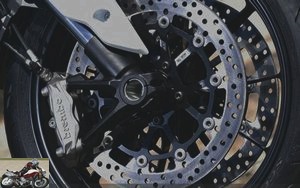
Comfort and duo
The conditions of the test did not allow the duo to be tested, but the comfort of the front portion was evident. On the other hand, the dug base limits mobility and over time risks anchoring the base on long motorway journeys. The (future) owners are of course invited to give their opinion here.
Driving aids
The Hyperstrada offers 3 pre-programmed driving modes to vary instantly, even while driving, the power delivered by the engine and the intervention levels of the ABS and Ducati Traction Control systems. By accessing the submenus, it is possible to disconnect the two systems or to customize the level of DTC and ABS intervention for each mode ….
SPORT: Riding Mode Sport delivers a power of 110 hp. with direct Ride by Wire response to throttle opening, reduced DTC system intervention (level 3 out of 8) and level 1 (most permissive) ABS system with reduced rear lift control.
TOURING: Always 110 hp. but with a more progressive response of the Ride by Wire to the opening of the throttle, a more important intervention of the DTC system (level 4 of 8) and level 2 (of 2) of the ABS system with the maximum of stability during braking.
URBAN: the Riding Mode Urban restricts the power to 75 HP with an even more progressive response to the opening of the throttle, the DTC system is set on level 6 and ABS on level 2.
Practical aspects and accessories
Each side case (25 liters) is able to accommodate a full face helmet and can be fitted with a waterproof bag. Besides the fact that the unlocking is done with the ignition key, the very discreet fixing plates do not disfigure the profile once the elements have been removed. The passenger handle / luggage carrier assembly is predisposed to accommodate an additional top case. The center stand is very easy to operate (unlike the side stand) and requires little effort. The only downside is that the high screen has no height adjustment.
Consumption
Autonomy side, it will depend on the driving pace. From 4 liters in break-in to 8 or even 9 liters on the attack, the average autonomy should be a little above the 220 km mark before attacking the reserve of 3.5 L and the very calm ones will even be able to consider exceeding the 300 km mark before draining the 16 liters of the tank. Finally an SM with autonomy !
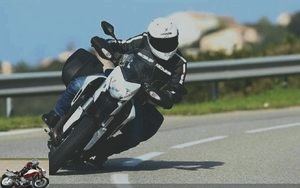
Conclusion
Don’t be fooled by the name, this Hyperstrada is not a GT. On the other hand, it appears thus rigged as a remarkably versatile machine and perfectly usable on a daily basis by erasing the two biggest flaws of the SM genre, namely autonomy and saddle height. It remains for Ducati to improve ground clearance and equip its fork with adjustments to make it a perfectly homogeneous machine and fully unlock all its sporting potential. Certainly, with a price of € 12,790, its price is high. But apart from the KTM SMT 990 which is in exactly the same category, it has no direct competitor. We can find a wiser alternative at Honda with its "trail" Crossrunner and another less efficient on the attack and more traveling (but no less fun) at Triumph with the Tiger 800.
Strong points
- True versatility
- Liveness of the chassis
- Motor
- Driving aids
- Autonomy
Weak points
- Supermoto style to be avoided in the attack
- Fork not adjustable and a bit too soft
- Ground clearance to improve
- Brutal braking attack
Competitors: Aprilia Dorsoduro 750, KTM SMT 990
Skills
- Leisure

- Road

- Sport

- Utility

Ducati Hyperstrada technical sheet
Our thanks to Moto Prestige d’Ajaccio, the first Ducati dealership open on the Isle of Beauty for their supervision and help in organizing our trip.
Related articles
-
Yamaha Fazer 1000 motorcycle test
Arrival in France at the beginning of the year 2001, the big sister of the FZS 600 Fazer is available at dealers since March. Three months later, she…
-
A power cruiser with Italian sauce. Punch, style, noise, character ! V2 1262 cm3, 152 hp at 9,500 rpm, 12.8 m / kg at 5,000 rpm, 220 kilos dry, from…
-
Indian 1200 FTR Rally motorcycle test
Bite V-Twin, 1203 cm3, 120 hp, 120 Nm at 6,000 rpm, 235 kg TPF, 14,990 euros … daily test The word scrambler warms up lots of images, broadcast, told,…
-
Honda CMX 500 Rebel S motorcycle test
Little rebellious bobber In-line twin, 471 cm3, 45 hp at 8,500 rpm, 44.6 Nm at 6,000 rpm, 190 kilos, € 6,299 Rather bi or 4? It’s that the couple is…
-
Ducati 1098 motorcycle test – 160 hp in free version
There are times in a biker life where the emotional strikes, in the heart ! I remember when the 916 was released : what a slap! A stroke of genius signed…
-
Kawasaki Z H2 Supercharged motorcycle test
200 hp, 14 mkg at 8,500 rpm, 239 kg all full, 17,099 € Put some salt ! Fifteen days of driving with the Kawasaki Z H2? I say it bluntly, it takes less to…
-
Suzuki DL 650 VStrom motorcycle test – 2012 vintage
Aids for the road 10 years of good and loyal service … the DL 650 VStrom indeed celebrates a nice anniversary in 2012, without having succeeded in…
-
Biker test: David B. At first look the BMW R1150R serves a design combining class and sobriety. The lines are more worked than on the old R1100R and the…
-
Yamaha XJR 1300 motorcycle test
The arsouilleur grenadier The XJR is one of the old and big roadsters just like the Bandit 1200 and the ZRX 1200 which cut their teeth and proved their…
-
Triumph Sprint GT motorcycle test
Mister Hyde in velvet panties !! 3500 km test Triumph unveiled the Sprint GT in 2010, evolving into a more road version of the ST. Seen from the front,…